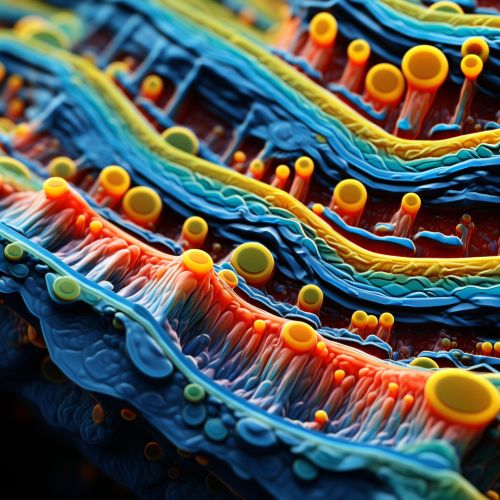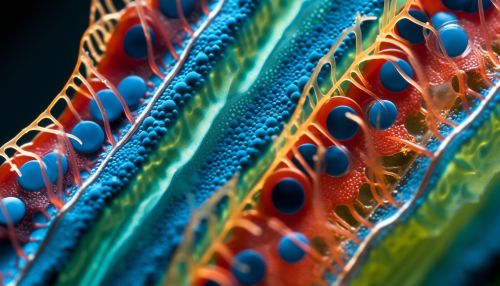Peptidoglycan
Structure and Composition
Peptidoglycan, also known as murein, is a polymer consisting of sugars and amino acids that forms a mesh-like layer outside the plasma membrane of most bacteria, forming the cell wall. The sugar component consists of alternating residues of β-(1,4) linked N-acetylglucosamine (NAG) and N-acetylmuramic acid (NAM). Attached to the N-acetylmuramic acid is a peptide chain of three to five amino acids. The peptide chain can be cross-linked to the peptide chain of another strand forming the 3D mesh-like layer. Peptidoglycan serves a structural role in the bacterial cell wall, giving structural strength, as well as counteracting the osmotic pressure of the cytoplasm. Peptidoglycan is also involved in binary fission during bacterial cell reproduction.


Biosynthesis
Peptidoglycan biosynthesis involves a series of enzyme reactions that occur in the cytoplasm and the cell membrane. The process begins with the synthesis of the peptidoglycan monomer unit: a disaccharide-pentapeptide, in the cytoplasm. This monomer unit is then attached to a carrier molecule, bactoprenol, which transports it across the cell membrane. Once the monomer unit is outside the cell membrane, it is polymerized with other monomer units to form the peptidoglycan polymer. The polymerization process involves the formation of glycosidic bonds between the sugars of the monomer units, and peptide bonds between the amino acids. The final step in peptidoglycan biosynthesis is the cross-linking of the peptide chains, which is catalyzed by the enzyme transpeptidase.
Role in Bacterial Cell Wall
The peptidoglycan layer of the bacterial cell wall is a critical component that provides structural integrity and protection. It acts as a pressure vessel, preventing lysis due to the high osmotic pressure difference between the inside and outside of the cell. The rigidity of the peptidoglycan layer is due to its cross-linked peptide chains, which form a strong and flexible network. Additionally, the peptidoglycan layer provides a porous structure that allows the passage of small molecules and ions, which is essential for the cell's metabolic functions.
Variations in Different Bacteria
Peptidoglycan structure varies significantly between different types of bacteria. The primary distinction is between Gram-positive and Gram-negative bacteria. Gram-positive bacteria have a thick peptidoglycan layer, which can be up to 90% of the cell wall's total mass. This thick layer is responsible for the retention of the crystal violet dye used in the Gram staining procedure, leading to a positive result. On the other hand, Gram-negative bacteria have a thin peptidoglycan layer, which is located between the inner and outer membranes of the cell wall. The thin peptidoglycan layer does not retain the crystal violet dye, resulting in a negative Gram stain result.
Clinical Significance
Peptidoglycan is a target for several antibiotics, including penicillin and other beta-lactam antibiotics. These drugs inhibit the final transpeptidation step of peptidoglycan synthesis, preventing the cross-linking of the peptide chains. This inhibition weakens the cell wall, leading to bacterial cell lysis and death. Furthermore, the human immune system recognizes peptidoglycan as a molecular pattern associated with bacterial infection, triggering an immune response.
